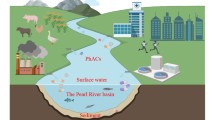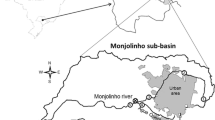Abstract
The occurrence, partitioning, and spatio-temporal distribution of seven pharmaceuticals for human use, three steroid hormones and one personal care product were determined in surface water, suspended particulate matter (SPM), and sediment of Piraí Creek and Jundiaí River (Jundiaí River Basin, São Paulo, Brazil). The maximum average detected concentrations of the compounds in the Piraí River samples were < 30 ng L−1, except for caffeine (222 ng L−1). In Jundiaí River samples, most of the compounds were frequently detected, wherein caffeine had the highest concentration, with maximum average concentrations of 14,050 ng L−1, followed by atenolol (431 ng L−1), ibuprofen (268 ng L−1) and diclofenac (214 ng L−1). Atenolol, propranolol, estrone, and triclosan were the contaminants most frequently detected in sediment and SPM samples. Triclosan had the highest average proportion of SPM as opposed to in the aqueous phase (> 75%). Contaminants with acid functional groups showed, in general, a lower tendency to bind to particulate matter and sediments. In addition, hydrophobicity had an important effect on their environmental partitioning. The spatial distribution of contaminants along the Jundiaí River was mainly affected by the higher concentration of contaminants in water samples collected downstream from a sewage treatment plant (STP). The results obtained here clearly showed the importance of the analysis of some contaminants in the whole water, meaning both dissolved and particulate compartments in the water, and that the partitioning is ruled by a set of parameters associated to the physicochemical characteristics of contaminants and the matrix properties of the studied, which need be considered in an integrated approach to understand the fate of emerging chemical contaminants in aquatic environments.





Similar content being viewed by others
References
Ademollo N, Patrolecco L, Polesello S, Valsecchi S, Wollgast J, Mariani G, Hanke G (2012) The analytical problem of measuring total concentrations of organic pollutants in whole water. TrAC Trends Anal Chem 36:71–81. https://doi.org/10.1016/j.trac.2012.01.008
Andrási N, Molnár B, Dobos B, Vasanits-Zsigrai A, Záray G, Molnár-Perl I (2013) Determination of steroids in the dissolved and in the suspended phases of wastewater and Danube River samples by gas chromatography, tandem mass spectrometry. Talanta 115:367–373. https://doi.org/10.1016/j.talanta.2013.05.029
Babić S, Horvat AJM, Pavlović DM, Kaštelan-Macan M (2007) Determination of pKa values of active pharmaceutical ingredients. TrAC Trends Anal Chem 26(11):1043–1061. https://doi.org/10.1016/j.trac.2007.09.004
Baker DR, Kasprzyk-Hordern B (2013) Spatial and temporal occurrence of pharmaceuticals and illicit drugs in the aqueous environment and during wastewater treatment: new developments. Sci Total Environ 454-455:442–456. https://doi.org/10.1016/j.scitotenv.2013.03.043
Baker DR, Očenášková V, Kvicalova M, Kasprzyk-Hordern B (2012) Drugs of abuse in wastewater and suspended particulate matter—further developments in sewage epidemiology. Environ Int 48:28–38. https://doi.org/10.1016/j.envint.2012.06.014
Barber MC (2008) Dietary uptake models used for modeling the bioaccumulation of organic contaminants in fish. Environ Toxicol Chem 27(4):755–777. https://doi.org/10.1897/07-462.1
Benotti MJ, Trenholm RA, Vanderford BJ, Holady JC, Stanford BD, Snyder SA (2009) Pharmaceuticals and endocrine disrupting compounds in U.S. drinking water. Environ Sci Technol 43(3):597–603. https://doi.org/10.1021/es801845a
Buerge IJ, Poiger T, Muller MD, Buser H-R (2003) Caffeine, an anthropogenic marker for wastewater contamination of surface waters. Environ. Sci. Technol. 37(4):691–700. https://doi.org/10.1021/es020125z
Caliman FA, Gavrilescu M (2009) Pharmaceuticals, personal care products and endocrine disrupting agents in the environment—a review. CLEAN - Soil, Air, Water 37(4-5):277–303. https://doi.org/10.1002/clen.200900038
Campanha MB, Awan AT, de Sousa DNR, Grosseli GM, Mozeto AA, Fadini PS (2015) A 3-year study on occurrence of emerging contaminants in an urban stream of São Paulo State of Southeast Brazil. Environ Sci Pollut Res Int 22(10):7936–7947. https://doi.org/10.1007/s11356-014-3929-x
Da Silva BF, Jelic A, López-Serna R, Mozeto AA, Petrovic M, Barceló D (2011) Occurrence and distribution of pharmaceuticals in surface water, suspended solids and sediments of the Ebro river basin, Spain. Chemosphere 85(8):1331–1339. https://doi.org/10.1016/j.chemosphere.2011.07.051
Darwano H, Duy SV, Sauvé S (2014) A new protocol for the analysis of pharmaceuticals, pesticides, and hormones in sediments and suspended particulate matter from rivers and municipal wastewaters. Arch Environ Contam Toxicol 66(4):582–593. 10.1007/s00244-014-0007-9
De Sousa DNR, Grosseli GM, Mozeto AA, Carneiro RL, Fadini PS (2015) Ultrasound-assisted extraction method for the simultaneous determination of emerging contaminants in freshwater sediments. J Sep Sci 38(19):3454–3460. https://doi.org/10.1002/jssc.201500644
De Sousa DNR, Mozeto AA, Carneiro RL, Fadini PS (2014) Electrical conductivity and emerging contaminant as markers of surface freshwater contamination by wastewater. Sci Total Environ 484:19–26. https://doi.org/10.1016/j.scitotenv.2014.02.135
Decision C (2002) COMMISSION DECISION of 12 August 2002 implementing Council Directive 96/23/EC concerning the performance of analytical methods and the interpretation of results 8–36
Duan Y-P, Meng X-Z, Wen Z-H, Ke R-H, Chen L (2013) Multi-phase partitioning, ecological risk and fate of acidic pharmaceuticals in a wastewater receiving river: the role of colloids. Sci Total Environ 447:257–273
Esteban S, Gorga M, Petrovic M, González-Alonso S, Barceló D, Valcárcel Y (2014) Analysis and occurrence of endocrine-disrupting compounds and estrogenic activity in the surface waters of Central Spain. Sci Total Environ 466-467:939–951. https://doi.org/10.1016/j.scitotenv.2013.07.101
La Farré M, Pérez S, Kantiani L, Barceló D (2008) Fate and toxicity of emerging pollutants, their metabolites and transformation products in the aquatic environment. TrAC Trends Anal Chem 27(11):991–1007. https://doi.org/10.1016/j.trac.2008.09.010
Fatta-Kassinos D, Meric S, Nikolaou A (2011) Pharmaceutical residues in environmental waters and wastewater: current state of knowledge and future research. Anal Bioanal Chem 399(1):251–275. https://doi.org/10.1007/s00216-010-4300-9
Fent K, Weston AA, Caminada D (2006) Ecotoxicology of human pharmaceuticals. Aquat Toxicol 76(2):122–159. https://doi.org/10.1016/j.aquatox.2005.09.009
Gaskell PN, Brooks AC, Maltby L (2007) Variation in the bioaccumulation of a sediment-sorbed hydrophobic compound by benthic macroinvertebrates: patterns and mechanisms. Environ Sci Technol 41(5):1783–1789. https://doi.org/10.1021/es061934b
Gavrilescu M, Demnerová K, Aamand J, Agathos S, Fava F (2014) Emerging pollutants in the environment: present and future challenges in biomonitoring, ecological risks and bioremediation. New Biotechnol 32(1):147–156. https://doi.org/10.1016/j.nbt.2014.01.001
Gómez MJ, Herrera S, Solé D, García-Calvo E, Fernández-Alba AR (2012) Spatio-temporal evaluation of organic contaminants and their transformation products along a river basin affected by urban, agricultural and industrial pollution. Sci Total Environ 420:134–145. https://doi.org/10.1016/j.scitotenv.2012.01.029
Heim S, Schwarzbauer J (2013) Pollution history revealed by sedimentary records: a review. Environ Chem Lett 11(3):255–270. https://doi.org/10.1007/s103111-013-0409-3
Huerta-Fontela M, Galceran MT, Ventura F (2011) Occurrence and removal of pharmaceuticals and hormones through drinking water treatment. Water Res 45(3):1432–1442. https://doi.org/10.1016/j.watres.2010.10.036
Jiang J-Q, Zhou Z, Sharma VK (2013) Occurrence, transportation, monitoring and treatment of emerging micro-pollutants in waste water—a review from global views. Microchem J 110:292–300. https://doi.org/10.1016/j.microc.2013.04.014
Kasprzyk-Hordern B, Dinsdale RM, Guwy AJ (2009) The removal of pharmaceuticals, personal care products, endocrine disruptors and illicit drugs during wastewater treatment and its impact on the quality of receiving waters. Water Res 43(2):363–380. https://doi.org/10.1016/j.watres.2008.10.047
Kim J, Jang H, Kim J, Ishibashi H, Hirano M, Nasu K, Ichikawa N, Takao Y, Shinohara R, Arizono K (2009) Occurrence of pharmaceutical and personal care products (PPCPs) in surface water from Mankyung River, South Korea. J Health Sci 55(2):249–258. https://doi.org/10.1248/jhs.55.249
Kolpin DW, Skopec M, Meyer MT, Furlong ET, Zaugg SD (2004) Urban contribution of pharmaceuticals and other organic wastewater contaminants to streams during differing flow conditions. Sci Total Environ 328(1-3):119–130. https://doi.org/10.1016/j.scitotenv.2004.01.015
Kopperi M, Ruiz-Jiménez J, Hukkinen JI, Riekkola M-L (2013) New way to quantify multiple steroidal compounds in wastewater by comprehensive two-dimensional gas chromatography-time-of-flight mass spectrometry. Anal Chim Acta 761:217–226. https://doi.org/10.1016/j.aca.2012.11.059
Lahti M, Oikari A (2011) Pharmaceuticals in settleable particulate material in urban and non-urban waters. Chemosphere 85(5):826–831. https://doi.org/10.1016/j.chemosphere.2011.06.084
Lai KM, Johnson KL, Scrimshaw MD, Lester JN (2000) Binding of waterborne steroid estrogens to solid phases in river and estuarine systems. Environ Sci Technol 34(18):3890–3894. https://doi.org/10.1021/es9912729
Li WC (2014) Occurrence, sources, and fate of pharmaceuticals in aquatic environment and soil. Environ Pollut 187:193–201. https://doi.org/10.1016/j.envpol.2014.01.015
López-Roldán R, De Alda ML, Gros M, Petrovic M, Martín-Alonso J, Barceló D (2010) Advanced monitoring of pharmaceuticals and estrogens in the Llobregat River basin (Spain) by liquid chromatography-triple quadrupole-tandem mass spectrometry in combination with ultra performance liquid chromatography-time off light-mass spectrometry. Chemosphere 80(11):1337–1344. https://doi.org/10.1016/j.chemosphere.2010.06.042
Machado KS, Cardoso FD, Azevedo JCR, Braga CB (2014) Occurrence of female sexual hormones in the Iguazu river basin, Curitiba, Paraná State, Brazil. Acta. Sci Technol 36(3):421. https://doi.org/10.4025/actascitechnol.v36i3.18477
Montagner CC, Jardim WF (2011) Spatial and seasonal variations of pharmaceuticals and endocrine disruptors in the Atibaia River, São Paulo State (Brazil). J Braz Chem Soc 22(8):1452–1462. https://doi.org/10.1590/S0103-50532011000800008
Montagner CC, Jardim WF, Von der Ohe PC, Umbuzeiro GA (2013) Occurrence and potential risk of triclosan in freshwaters of São Paulo, Brazil-the need for regulatory actions. Environ Sci Pollut Res Int 21(3):1850–1858. https://doi.org/10.1007/s11356-013-2063-5
Patrolecco L, Capri S, Ademollo N (2015) Occurrence of selected pharmaceuticals in the principal sewage treatment plants in Rome (Italy) and in the receiving surface waters. Environ Sci Pollut Res 22(8):5864–5876. https://doi.org/10.1007/s11356-014-3765-z
Peeler KA, Opsahl SP, Chanton JP (2006) Tracking anthropogenic inputs using caffeine, indicator bacteria, and nutrients in rural freshwater and urban marine systems. Environ. Sci. Technol. 40(24):7616–7622. https://doi.org/10.1021/es061213c
Pedrouzo M, Reverté S, Borrull F, Pocurull E, Marcé RM (2007) Pharmaceutical determination in surface and wastewaters using high-performance liquid chromatography-(electrospray)-mass spectrometry. J Sep Sci 30(3):297–303. https://doi.org/10.1002/jssc.200600269
Pessoa GP, de Souza NC, Vidal CB, Alves JAC, Firmino PIM, Nascimento RF, dos Santos AB (2014) Occurrence and removal of estrogens in Brazilian wastewater treatment plants. Sci Total Environ 490:288–295. https://doi.org/10.1016/j.scitotenv.2014.05.008
Petrovic M, Eljarrat E, Lopez de Alda MJ, Barceló D (2004) Endocrine disrupting compounds and other emerging contaminants in the environment: a survey on new monitoring strategies and occurrence data. Anal Bioanal Chem 378(3):549–562. https://doi.org/10.1007/s00216-003-2184-7
Schwarzenbach RP, Egli T, Hofstetter TB, von Gunten U, Wehrli B (2010) Global water pollution and human health. Annu Rev Environ Resour 35(1):109–136. https://doi.org/10.1146/annurev-environ-100809-125342
Schubert B, Heininger P, Keller M, Ricking M, Claus E (2012) Monitoring of contaminants in suspended particulate matter as an alternative to sediments. TrAC Trends Anal Chem 36:58–70. https://doi.org/10.1016/j.trac.2012.04.003
Shala L, Foster GD (2010) Surface water concentrations and loading budgets of pharmaceuticals and other domestic-use chemicals in an urban watershed (Washington, DC, USA). Arch Environ Contam Toxicol 58(3):551–561. https://doi.org/10.1007/s00244-009-9463-z
Sui Q, Huang J, Deng S, Yu G, Fan Q (2010) Occurrence and removal of pharmaceuticals, caffeine and DEET in wastewater treatment plants of Beijing, China. Water Res 44(2):417–426. https://doi.org/10.1016/j.watres.2009.07.010
Tadeo JL, Sánchez-Brunete C, Albero B, García-Valcárcel AI, Pérez RA (2012) Analysis of emerging organic contaminants in environmental solid samples. Cent Eur J Chem 10(3):480–520. https://doi.org/10.2478/s11532-011-0157-9
Teijon G, Candela L, Tamoh K, Molina-Díaz A, Fernández-Alba AR (2010) Occurrence of emerging contaminants, priority substances (2008/105/CE) and heavy metals in treated wastewater and groundwater at Depurbaix facility (Barcelona, Spain). Sci Total Environ 408(17):3584–3595. https://doi.org/10.1016/j.scitotenv.2010.04.041
Thomas KV, da Silva FMA, Langford KH, de Souza ADL, Nizzeto L, Waichman AV (2014) Screening for selected human pharmaceuticals and cocaine in the urban streams of Manaus, Amazonas, Brazil. JAWRA. J Am Water Resour Assoc 50(2):302–308. https://doi.org/10.1111/jawr.12164
Warren N, Allan IJ, Carter JE, House WA, Parker A (2003) Pesticides and other micro-organic contaminants in freshwater sedimentary environments—a review. Appl Geochem 18(2):159–194. https://doi.org/10.1016/S0883-2927(02)00159-2
Veach AM, Bernot MJ (2011) Temporal variation of pharmaceuticals in an urban and agriculturally influenced stream. Sci Total Environ 409(21):4553–4563. https://doi.org/10.1016/j.scitotenv.2011.07.022
Vignati DAL, Valsecchi S, Polesello S, Patrolecco L, Dominik J (2009) Pollutant partitioning for monitoring surface waters. TrAC Trends Anal Chem 28(2):159–169. https://doi.org/10.1016/j.trac.2008.10.013
Vystavna Y, HUneau F, Grynenko V, Vergeles Y, Celle-Jeanton H, Tapie N, Budzinski H, Le Coustumer P (2012) Pharmaceuticals in rivers of two regions with contrasted socio-economic conditions: occurrence, accumulation, and comparison for Ukraine and France. 233:2111–2124. doi:https://doi.org/10.1007/s11270-011-1008-1
Funding
The authors are grateful to the São Paulo Research Foundation (FAPESP), Grant nos. 2010/01731-0 and 2014/21871-2, CNPq, and PETROBRAS-ANP.
Author information
Authors and Affiliations
Corresponding author
Additional information
Responsible editor: Roland Kallenborn
Electronic supplementary material
ESM 1
(DOCX 54 kb)
Rights and permissions
About this article
Cite this article
de Sousa, D.N.R., Mozeto, A.A., Carneiro, R.L. et al. Spatio-temporal evaluation of emerging contaminants and their partitioning along a Brazilian watershed. Environ Sci Pollut Res 25, 4607–4620 (2018). https://doi.org/10.1007/s11356-017-0767-7
Received:
Accepted:
Published:
Issue Date:
DOI: https://doi.org/10.1007/s11356-017-0767-7




